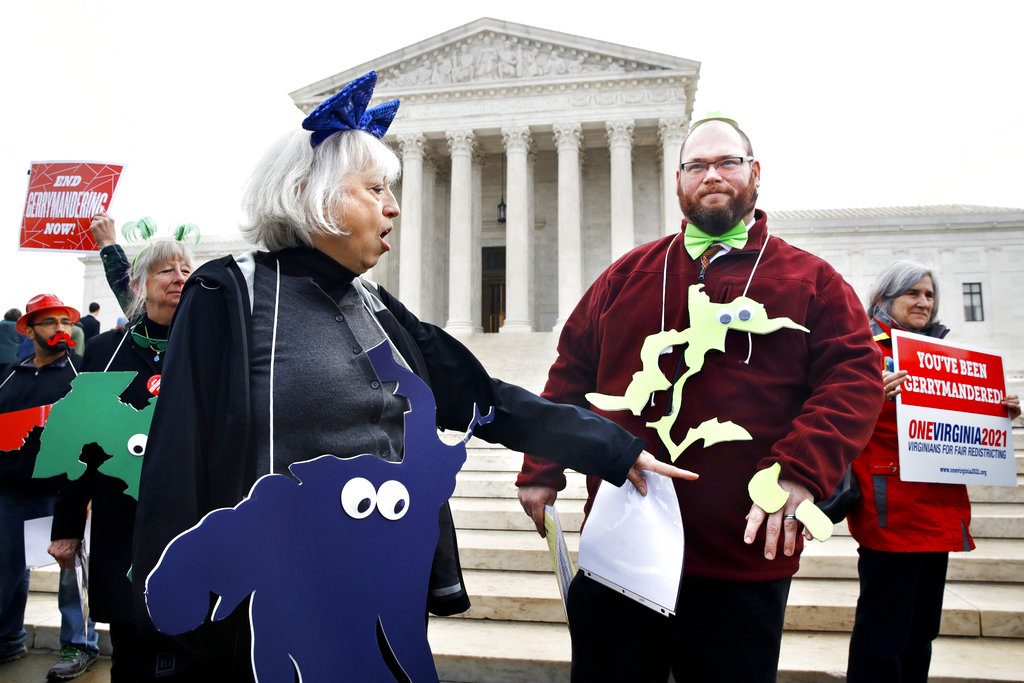Justices struggle with partisan redistricting case again (UPDATE)
By: Associated Press//March 28, 2018//
Justices struggle with partisan redistricting case again (UPDATE)
By: Associated Press//March 28, 2018//

By MARK SHERMAN
Associated Press
WASHINGTON (AP) — Dealing with questions that could affect elections across the country, U.S. Supreme Court justices wrestled on Wednesday with how far states may go to draw up electoral districts that give the majority party a huge political advantage.
But even as they heard their second case on partisan redistricting in six months, the justices expressed uncertainty about the best way to deal with a situation that several said would get worse without the court’s intervention.
The arguments the court heard on Wednesday were over an appeal by Republican voters in Maryland who object to a congressional district that Democrats drew to elect a candidate of their own.
The Maryland case is a companion to one from Wisconsin, in which Democrats are complaining about a Republican-drawn map of legislative districts. That case was argued in October and remains undecided.
Justice Stephen Breyer suggested that the court could add in yet a third case involving North Carolina’s congressional district and set another round of arguments to deal with all three states.
Breyer’s comment is a sign that the justices haven’t figured out the Wisconsin case in the nearly six months since it was argued.
More importantly, it suggests that Justice Anthony Kennedy, whose vote almost certainly controls the outcome, has reservations about using the Wisconsin case for the court’s first-ever ruling that districting plans that entrench one party’s control of the legislature or congressional delegation can violate the constitutional rights of the other party’s voters.
The Maryland lawsuit offers the court a more limited approach to dealing with gerrymandering because it involves just one district that flipped from Republican to Democratic control after the 2011 round of redistricting.
There was broad agreement that the Republican voters who sued had presented what Justice Sonia Sotomayor called “pretty damning” evidence that the Democrats who controlled the state government wanted to increase the Democrats’ edge in the congressional from 6-2 to 7-1. Even Chief Justice John Roberts, who has questioned lawsuits over partisan redistricting, said the redrawing of the 6th congressional district seemed to lack “any internal logic,” other than to elect a Democrat.
Residents of the wealthy Washington, D.C., suburb of Potomac, Maryland, were lumped in with people who live in the rural northwestern corner of the state, Roberts said. “They both have farms. But the former, hobby farms. And the others are real farms.”
But Roberts was among several justices who drew attention to a procedural hurdle that could keep the court from deciding the merits of the case. And the same holds true for the Wisconsin case.
That’s where Breyer’s suggestion could come in. He said even a decision striking down the Maryland map, which he said seems to be an extreme gerrymander, “will not do much to deal with a problem of serious dimensions, which is national.”
If the court doesn’t confront the big questions now, Breyer said, sophisticated map-makers using increasingly powerful technology will come up with even more effective partisan maps after the 2020 census.
Putting all the challenged plans together would allow for a comprehensive ruling, he said.
Over the past 16 months, courts have struck down political districting plans drawn by Republicans in North Carolina, Pennsylvania and Wisconsin. Federal judges threw out a state legislative map in Wisconsin and a congressional plan in North Carolina. In Pennsylvania, the state Supreme Court invalidated the state’s congressional districts and replaced them with a court-drawn plan.
The Supreme Court has put the drawing of new maps on hold in North Carolina and Wisconsin, but refused to block the Pennsylvania court’s adoption of revised congressional districts for this year’s elections.
Legal News
- State Bar leaders remain deeply divided over special purpose trust
- Former Wisconsin college chancellor fired over porn career is fighting to keep his faculty post
- Pecker says he pledged to be Trump campaign’s ‘eyes and ears’ during 2016 race
- A conservative quest to limit diversity programs gains momentum in states
- Wisconsin prison inmate pleads not guilty to killing cellmate
- Waukesha man sentenced to 30 years for Sex Trafficking
- 12-year-old shot in Milwaukee Wednesday with ‘serious injuries’
- Milwaukee man convicted of laundering proceeds of business email compromise fraud schemes
- Giuliani, Meadows among 18 indicted in Arizona fake electors case
- Some State Bar diversity participants walk away from program
- Wisconsin court issues arrest warrant ‘in error’ for Minocqua Brewing owner
- Iranian nationals charged cyber campaign targeting U.S. Companies
WLJ People
- Power 30 Personal Injury Attorneys – Russell Nicolet
- Power 30 Personal Injury Attorneys – Benjamin Nicolet
- Power 30 Personal Injury Attorneys – Dustin T. Woehl
- Power 30 Personal Injury Attorneys – Katherine Metzger
- Power 30 Personal Injury Attorneys – Joseph Ryan
- Power 30 Personal Injury Attorneys – James M. Ryan
- Power 30 Personal Injury Attorneys – Dana Wachs
- Power 30 Personal Injury Attorneys – Mark L. Thomsen
- Power 30 Personal Injury Attorneys – Matthew Lein
- Power 30 Personal Injury Attorneys – Jeffrey A. Pitman
- Power 30 Personal Injury Attorneys – William Pemberton
- Power 30 Personal Injury Attorneys – Howard S. Sicula











